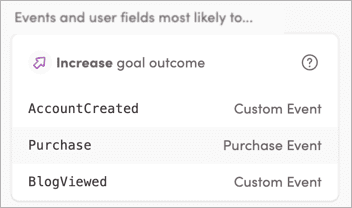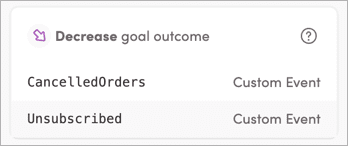The holidays are fast approaching, and before we know it, we’ll be entering 2025. Wouldn’t it be great to see into the future and start planning marketing campaigns that will set your brand up for success?
Well, now you can—with Iterable’s Predictive Goals. If you’re not familiar with this AI-powered feature, here’s a quick refresher on everything you need to know.
What is Predictive Goals?
Recent data privacy and protection changes have motivated brands to more ethically and effectively measure their personalization effectiveness. They’re shifting their focus away from vanity engagement metrics and towards delivering business outcomes and lifetime value for their customers.
Predictive Goals, included in Iterable’s AI Suite, enables marketers to drive outcome-based marketing based on forecasting their customers’ individualized probability to carry out future actions.


Iterable’s Predictive Goals gives you a crystal ball for your business outcomes.
Who should use Predictive Goals?
According to our findings with Wakefield Research and Ad Age, 50% of marketers report that predictive AI would make their jobs easier.
Ad Age states “When combined with predictive analytics, AI-driven automation features can help marketers strengthen customer relationships, improve brand performance, and meet their KPIs in today’s fast-moving marketplace.”
Iterable’s Predictive Goals is useful to brands that want to leverage first-party data to intelligently identify, track, and create customer segments, based on their likelihood to take a specific action. This solution allows marketers to tailor their messaging even further and maximize their campaign conversions.
What are the benefits of Predictive Goals?
The purpose of Predictive Goals is to bridge the gap between insight and action.
From maximizing revenue, to decreasing churn, to driving lifetime value, Predictive Goals provides marketers a versatile and intelligent way to proactively forecast how likely or unlikely individual customers are to satisfy a particular goal that’s unique to your business.
The end result is a powerful tool that helps marketers gain new insights and inspire smarter personalization strategies.
“Predictive Goals has been an absolute game-changer for our team, maximizing our efficiencies and accelerating time to value. We’ve seen the tangible benefits of AI on our business, and look forward to seeing the impact of Iterable’s new AI innovations.” ~ Lisa Tulloch, Email Marketing Channel Manager at Redfin
How does Predictive Goals work?
With this AI-powered feature, you can define and create multiple goals based on certain data points, including system events and custom properties. Predictive Goals takes in that data, scores all users, and predicts the likelihood that those users will convert on each goal.
Iterable’s Predictive Goals isn’t limited to specific use cases, like predicting churn or purchases. Instead, it offers more versatility by supporting both positive and negative goals—and allowing marketers to fully customize what goals are most important to their business.
Positive predictive goals can include optimizing for purchases, app downloads, sign-ups, or journey milestones.


In the example above, if you want to increase engagement with your brand, you should focus on creating campaigns that motivate users to create accounts, make purchases, and view your blog.
Negative predictive goals, however, might include minimizing or preventing churn, cart abandonment, or disengagement.


Continuing our example, if your goal is to increase brand engagement, you’ll want to see fewer instances of users canceling orders and unsubscribing.
There are no barriers or limitations in the kinds of goals you can create, as long as you have the data to support the prediction.
On the interactive chart on the Goal Details page, as seen below, you can scale the range of the prediction to define a user segment. Use the values reported to the right to understand how your selection impact the results you might expect.


With each prediction, you can view the users that are most or least likely to convert, or apply your own custom percentile range.
Once you’ve defined a user segment, you can then save your selection as either a static or dynamic list in Iterable.
This segmentation is valuable to incorporate in your journeys. For instance, if a user is likely to convert, they can be automatically triggered into a journey or moved down a particular path with relevant messaging.
To learn more about using Predictive Goals, review our support documentation and Academy courses: Predictive Goals and Applied AI.
Your Crystal Ball to Better Marketing Campaigns
While we can’t predict the exact future, we can place a solid bet that you’ll create more impactful marketing campaigns and drive higher customer lifetime value with Iterable’s Predictive Goals.
If you’re interested in bridging the gap between insights and action, our team is here to help.
To see Iterable’s Predictive Goals in action, reach out and schedule a demo today.
































